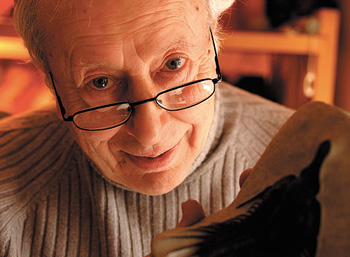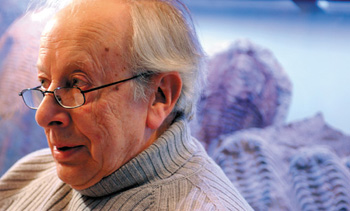Riccardo Levi-Setti —
Trilobites
He began “doing trilobites
to escape from physics,” Riccardo Levi-Setti confesses,
“but physics came back.” Professor emeritus
of physics and former director of the University’s
Enrico Fermi Institute, Levi-Setti is author of Trilobites
(Chicago, 1975, 1993), often considered the book on the
Paleozoic marine anthropods known as “butterflies
of the sea.”

Like butterflies trilobites can be divided
into a center and two side lobes (hence the name). They
resemble modern insects in other ways as well. An optics
expert whose development of a scanning ion microprobe (the
UC–SIM) has transformed how researchers in fields
from ceramics to cytogenetics look at micro particles, Levi-Setti
has used scanning electron microscopy to examine the visual
apparatus of trilobites, finding striking resemblances to
the compound eyes of modern insects. “Trilobites,”
he writes with professional tongue in cheek, “had
solved a very elegant physical problem and apparently knew
about Fermat’s principle, Abbé’s sine
law, Snell’s laws of refraction and the optics of
birefringent crystals.”
Born in Milan, Levi-Setti encountered
his first trilobite shortly after he came to Chicago in
1956, in a quarry west of the city. He now has uncovered
“thousands” of the fossils (while most are less
than two inches long, some can reach two-and-a-half feet)
but says that he collects for the experience: “I like
the process of digging them out. It’s a kind of treasure
hunt. You start with a chisel and blunt force.”

The delicacy of the fossil record means
that blunt force quickly yields to painstaking preparation.
Citing Michelangelo’s explanation of a sculpture—“I
saw the angel in the marble, and I chiseled until I set
it free!”—Levi-Setti says, “The true shape
is really in the rock and you have to be careful not to
break it.” Still, preparing specimens, which he does
in a basement workshop, “is very relaxing for me.
I think about papers that I have to write and write them
in my mind.”
Normally March would find him trilobite
hunting in Morocco, but this year war kept him home. A Holocaust
survivor who was part of the Italian resistance movement,
Levi-Setti finds solace in geologic time. “It’s
nice to think of life,” he says, “when man was
not around.”
—M.R.Y.
Select an expert:
Riccardo Levi-Setti - Trilobites
Richard Epstein - Parking
and Property
Mary Anne Case - Toilet
Inequities
Roman Weil - Vintage
Wine
Robert Grant - Sunken Submarines
David Galenson - Poetic
Values
John Milton - Poise
and Noise


![]() Advertising
Advertising
![]() About
the Magazine
About
the Magazine ![]() Alumni
Alumni
![]() UChicago
UChicago
![]()
![]() ©2003 The University
of Chicago® Magazine
©2003 The University
of Chicago® Magazine ![]() 5801 South Ellis Ave., Chicago, IL 60637
5801 South Ellis Ave., Chicago, IL 60637![]() fax: 773/702-0495
fax: 773/702-0495 ![]() uchicago-magazine@uchicago.edu
uchicago-magazine@uchicago.edu
